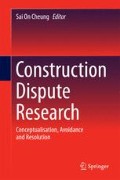Abstract
The formality of litigation and arbitration, with its concomitant escalation in costs, delays and adversarial relationship, have encouraged the rapid growth of alternative dispute resolution (ADR) processes, namely conciliation, mediation, adjudication and other hybrid processes (Brown and Marriott 1999; Fenn and Gameson 1992; Kaplan et al. 1991). These processes have been widely used and well received. For example, mediation is an integral part of dispute settlement clause in all conditions of contract for Hong Kong Government construction projects. Moreover, use of multiple-tier of ADR renders it impossible to obtain speedy and economic resolution. Overtly complicated ADR based resolution procedures destroy the original intents of having flexible and direct dispute resolution. In this study, a hierarchical model is developed to organise the different attributes of an ADR process. This arrangement fits neatly with the Analytical Hierarchy Process (AHP) methodology. AHP can be used to prioritise the attributes. The top ten ranked attributes are identified as critical attributes. These include, among others, preservation of relationship, enforceability, neutrality and consensus. This study also reports suggestions by experts on the means to enshrine these attributes. It is recommended that by focusing on these critical attributes, the dispute resolution process can be kept simple and effective.
Access this chapter
Tax calculation will be finalised at checkout
Purchases are for personal use only
References
Alhazmi, T., & McCaffer, R. (2000). Project procurement system selection model. Journal of Construction Engineering and Management ASCE, 126(3), 176–184.
Bevan, A. H. (1992). Alternative dispute resolution. London: Sweet & Maxwell.
Brooker, P., & Lavers, A. (2000a). Appropriate ADR—identifying features of construction disputes which affect their suitability for submission to ADR. ICLR, vol. 17, part 2.
Brooker, P., & Lavers, A. (2000b). Appropriate ADR and the CPR rules. International Council for Research and Innovation in Building and Construction, Working Commission 103 (W103) Construction Conflict: Avoidance and Resolution, Manchester.
Brown, H., & Marriott, A. (1999). ADR principles and practice (2nd ed.). London: Sweet & Maxwell.
Cheung, S. O. (1999). Critical factors affecting the use of alternative dispute resolution processes in construction. International Journal of Project Management, 17(3), 189–194.
Cheung, S. O., Lam, T. I., Leung, M. Y., & Wan, Y. W. (2001). An analytical hierarchy process bases procurement selection method. Construction Management and Economics, 19(4), 427–437.
Chua, D. K. H., Kog, Y. C., & Loh, P. K. (1999). Critical success factors for different project objectives. Journal of Construction Engineering and Management, 125(3), 142–150.
Construction Industry Review Committee (CIRC). (2001). Construct for excellence, construction industry review committee, The government of the Hong Kong Special Administrative Region.
David, J. (1988). Dispute resolution for lawyers-overview of range of dispute resolution processes. The University of Sydney, Faculty of Law, Continuing Legal Education, Sydney.
Egan, J. (1998). Rethinking construction, Department of the Environment, Transport and the Regions, HMSO, London.
ExpertChoice. (1998). Team expert choice: Advanced group decision support software. USA: ExpertChoice Inc.
Fong, S. W., & Choi, K. Y. (2000). Final contractor selection using the analytical hierarchy process. Construction Management and Economics, 18(5), 547–557.
Fenn, P., & Gameson, R. (1992). Construction conflict management. Proceedings of the First International Construction Management Conference. The University of Manchester. Institute of Science and Technology 25–27 September 1992, E & FN Spon., London.
Goldberg, S. B., Sander, F. E. A., & Roger, N. H. (1992). Dispute resolution-negotiation, mediation, and other processes. Canada: Little, Brown and Company.
Hibberd, P., & Newman, P. (1999). ADR and adjudication in construction disputes. London: Blackwell Science Ltd.
Hong Kong International Arbitration Centre (HKIAC). (2012). Hong Kong International Arbitration Centre Homepage: Services and Facilities. http://www.hkiac.org.
Kaplan, N., Spruce, J., & Cheng, T. Y. W. (1991). Hong Kong arbitration cases and materials. Hong Kong: Butterworths.
Kumaraswamy, M. M. (1997). Common categories and causes of construction claims. Construction Law Journal, 13(1), 21–34.
Latham, M. (1994). Constructing the team: final report by Sir Michael Latham. Joint Review of Procurement and Contractual Arrangements in the United Kingdom Construction Industry, HMSO, London.
Merna, A., & Bower, D. (1997). Dispute resolution in construction & infrastructure projects. Hong Kong: Asia Law & Practice Publishing Ltd.
Pengilley, W. (1990). Alternative dispute resolution: the philosophy and the need. Australian Dispute Resolution Journal, 1(2), 81–95.
Saaty, T. L. (1980). The analytical hierarchy process. New York: McGraw.
Saaty, T. L. (1988). The analytic hierarchy process: planning, priority setting, resources allocation. London: McGraw-Hill.
Saaty, T. L., & Vargas, L. G. (1991). Prediction, Projection and Forecasting. Boston: Kluwer Academic.
Shen, Q., Lo, K. K., & Wang, Q. (1998). Priority setting in maintenance: a modified multi-attribute approach using analytical hierarchy process. Construction Management and Economics, 16(6), 693–702.
Walker, A. (1996). Project management in construction. London: Blackwell Science.
Wall, C. (2000). What’s new in member countries: Hong Kong-monograph of practice and procedure in Hong Kong. International Council for Research and Innovation in Building and Construction, Working Commission 103 (W103) Construction Conflict: Avoidance and Resolution, Manchester.
York, S. (1996). Practical ADR. London: Person Professional Limited.
Acknowledgments
The authors would like to express their appreciation to the accredited mediators and arbitrators of the HKIAC for their information and participation in the research. The content of this chapter has been published in Volume 128(5) of the Journal of Construction Engineering and Management and is used with the permission from ASCE.
Author information
Authors and Affiliations
Corresponding author
Editor information
Editors and Affiliations
Rights and permissions
Copyright information
© 2014 Springer International Publishing Switzerland
About this chapter
Cite this chapter
Cheung, S.O. (2014). The Effective Use of ADR Processes in Construction. In: Cheung, S. (eds) Construction Dispute Research. Springer, Cham. https://doi.org/10.1007/978-3-319-04429-3_16
Download citation
DOI: https://doi.org/10.1007/978-3-319-04429-3_16
Published:
Publisher Name: Springer, Cham
Print ISBN: 978-3-319-04428-6
Online ISBN: 978-3-319-04429-3
eBook Packages: EngineeringEngineering (R0)

